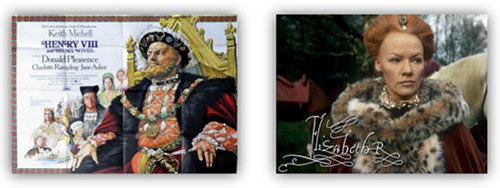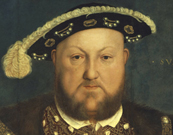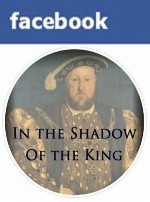First, I would like to reiterate one point:
"In the Shadow of the King" is a semi-fictional
account of the life of Sir Francis Bryan, in
particular his relationship with King Henry VIII.
Embellishment or omissions of certain historical
events, people (real or fictionalized), dialogues
and location descriptions were created or employed
solely by the author for storyline purposes during
the writing process.
That being said, it was always my intent to write
the book from a semi-fictional angle, fully aware
that fans of the historical period might take issue
with omissions or fabricated additions. Second, I
make no apologies for it. The book does include many
noted historical events, as well as several
fabricated ones. It is to be perused for entertainment
purposes at the behest of the reader.
 BACKGROUND
BACKGROUND
Delving into Tudor history came easily for me. I've
been obsessed with the era since I was nine years
old, when I first saw the original PBS/Masterpiece
Theatre series
The Six Wives of Henry VIII, which
starred the late actor Keith Michell as King Henry.
Subsequently, I became a huge fan of
Elizabeth R
(also debuting on PBS decades ago), featuring the
late Glenda
Jackson as Queen Elizabeth I. For the longest time, Michell and Jackson were synonymous in my mind as
the father-daughter characters they portrayed, and
still are to some extent.

Since then, I've avidly pursued the study of Tudor
history at my own behest. I have countless (but
probably numbering more than one hundred) tomes on
the subject, beginning with A Crown for
Elizabeth by Mary M. Luke, which was the first
book I ever read about the Tudor era. While none of
the basic history is new to me now, little bits of
information continue to trickle in, thus
intensifying my interest in the topic. Fairly recent
discoveries include a collection of Tudor coins
unearthed by a family weeding their garden in New
Forest, Southern England; a 16th-century warrant
book detailing instructions from Henry VIII on how
he ordered the execution of his second wife, Anne
Boleyn, to be carried out ("we command that the head
of the same Anne shall be cut off" at the Green
"within our Tower of London"), researchers offering
theories about Henry VIII's bouts of anger and
memory issues, and a discovery of the Mary Rose
shipwreck, which sank near the Isle of Wight in 1545
and provided insight into Tudor-era cod fishing.
Combining a real person from history with fictional
elements is a difficult task at times. It was made
more so by the scant information available about Sir
Francis Bryan. Although quite famous in his day,
many avenues of Bryan's life are shrouded in mystery
with no hints or plentiful historical documents to
light the way. However, I was able to find several
references to Bryan and his family tree, as well as
mention of him in official papers from the reign of
Henry VIII. There are plenty of resources out there,
you just have to find them.
Nonetheless, my first instinct was to tell the story
of Francis Bryan through the eyes of one of his
fictional descendants. Creating a fictional
storyline was the best option, considering little
information about Bryan's life is available. Plus,
I'm not an author of historical non-fiction. My
focus has always been fiction, regardless of the
subject matter. However, I'm also inclined to mix
fiction with non-fiction for storyline purposes,
such as putting in place real locations and people
amongst my fictional characters and mind-created
structures.
I also took liberties with various locations in the
storyline as most of the actual places no longer
exist, or are in ruins. I modeled Marsworth Manor,
Sir Francis Bryan's childhood home, on Castle Ashby
in rural Northamptonshire, England, while his final
residence, Butler Castle in Clonmel, Ireland was
entirely fictional but built around Malahide Castle
in County Dublin, Ireland. Interior descriptions of
the places came from online resources and my own
imagination, but hopefully illustrative of the times
in which they are based in the book. In additional,
descriptions of Francis Bryan's fictional house on
The Strand in London were based on a structure known
as the "Double Cottage," which is actually located
in Blaise Hamlet, Bristol, England.
Notations of diaries, letters, poems and songs are
presented in modern English rather than the language
of the times, with few exceptions.
 FICTIONAL AVENUES
FICTIONAL AVENUES
Whether Sir Francis Bryan had children, legitimate
or otherwise, is debatable, depending on the
resource chosen. I devoured the information to be
had on several websites, in print books, electronic
books and essays. Some sources refer to Sir Francis
Bryan as having "children unknown," while others
suggest he had an illegitimate son by Abigail Elwell
in 1518, another son named Edmund by his first wife
Phillipa Spice in 1522, and a third son dubbed
Francis by his second wife, Joan Butler, in 1549.
One genealogy website reports that Francis and
Philippa also had another son, Robert Bryan, date of
birth unknown. Mention of the second son is found in
Footprints in Time: Thirty-Two Generations of Bryans
by Linda Bryan Johnston. The author noted that data
concerning ancestry of Sir Francis Bryan is based
partly on research done by the Society of
Genealogists in London, The Dictionary of National
Biography, and the Complete Peerage. The same
websites report that Francis and Joan also had a
daughter, Margaret Elizabeth Bryan, born in 1548.
For storyline purposes, I went with the existence of
four children: John Bryan Elwell (illegitimate son
by Abigail Elwell), Edmund Bryan (by his first wife Phillipa Spice) and
Francis Bryan II (by his second
wife, Joan Butler), although circumstances and
dialog are highly embellished and of my own making.
Again, for storyline purposes, I gave the name
"John" to Sir Francis Bryan's illegitimate issue by
Abigail Elwell. Physical descriptions and
characteristics off all alleged three sons are
purely fictional, although I tried to be mindful as
actual events in history played out.
Fictional fourth child: The
existence of the character, Angela Perrette Quillon,
as Sir Francis Bryan's French mistress resulted in the
birth of an illegitimate daughter, Charlotte Bryan Quillon, in
September 1536. Both characters are purely
fictional.
There are several scenes and multiple dialogs in the
book that are of my own making, although more often
than not they are crafted on the peripherals of real
historical events or milestones in Tudor times.
In addition, mention of the Primero card
game in scenes from 1509 pre-date it's actual first
reference in 1526. The inclusion of the game in the
storyline was deliberate as I wanted to give Henry
VIII and Francis Bryan something to focus on as they
became acquainted in the early days of their
relationship. It also gave me the opportunity to
introduce Charles Brandon, Henry VIII's best friend,
into the mix.
The historical timeline included near the end of
In the Shadow of the King is mostly factual.
However, where little or no information is available
on the dates for specific events, certain notations
were established for the flow of the storyline. The
"Chapter Notes & Citations" section of
In the Shadow of the King details events and
locales that occurred in history. References are
included, as well as clarification of certain events
or locales that may have been altered for storyline
purposes. Use of the term "for storyline purposes"
is meant to explain alteration or embellishment of
certain events, dialogues and timelines so they go
hand-in-hand with the fictional aspect of the story.
I glossed over or omitted some events from real
history not for their lack of importance, but
because building a fictional setting and dialog
around every event - whether small or large - would
have propelled
In the Shadow of the King to a likely 1,000+
pages. Certain Tudorphiles might find fault with the
omission, alteration or addition of known or
fictional events in history, but I embellished as I
saw fit as the story progressed in my head. Any
faults, non-intended or otherwise, are purely the
responsibility of yours truly. It was not my intent
to short shrift readers, but leaving out certain
events was essential for the smooth flow of the
semi-fictional storyline.

While there are no known likenesses of Sir Francis
Bryan - allegedly because he was self-conscious
about his eye patch and refused to have his picture
painted - I decided to include an existing fictional
portrait, which was located at Butler Castle in the
storyline. Because I'm a
visually inspired author when it comes to
descriptions of people and locations, I based his
looks on two sources. The first was a sketch of a
16th-century man wearing an eye patch, credited to
John Wilhite at the website
Find-A-Grave (pictured above).
Then my publisher also came up with a rendering of
the man (pictured below), which hits the
nail on the head, in my opinion. Tall and
swaggering, Bryan simply had to be handsome in order
to earn his reputation as a rake in the court of
Henry VIII.

In the Shadow of the King is an ode to my nearly
lifelong fascination with all things Tudor.
Hopefully, I was able to do it justice, along with
the physical description of Sir Francis Bryan,
however he may appear in the reader's mind.
 "In the Shadow
of the King" Cast of Characters
(PDF)
"In the Shadow
of the King" Cast of Characters
(PDF)
 "In the Shadow
of the King" Background & Credits
(PDF)
"In the Shadow
of the King" Background & Credits
(PDF)
 "In the
Shadow of the King" Timelines
(PDF)
"In the
Shadow of the King" Timelines
(PDF)
 Books by
Deborah O'Toole (PDF)
Books by
Deborah O'Toole (PDF)
![]() King Unleashed (07/03/2023)
King Unleashed (07/03/2023)![]() "In the Shadow of the King" released by Club
Lighthouse Publishing. (07/02/2023)
"In the Shadow of the King" released by Club
Lighthouse Publishing. (07/02/2023)![]() King on the Way (03/26/2023)
King on the Way (03/26/2023)![]() "In the Shadow of the King" signed with Club
Lighthouse Publishing. (03/25/2023)
"In the Shadow of the King" signed with Club
Lighthouse Publishing. (03/25/2023)![]() Royal Finish (03/04/2023) *Updated
03/22/2023*
Royal Finish (03/04/2023) *Updated
03/22/2023*![]() New Royal Web (02/16/2023)
New Royal Web (02/16/2023)![]() Smoky Inspiration (02/04/2023)
Smoky Inspiration (02/04/2023)![]() Kingly Mish-Mash (01/24/2023)
Kingly Mish-Mash (01/24/2023)![]() Fictional Courtier Satire (01/14/2023)
Fictional Courtier Satire (01/14/2023)![]() Halfway In (01/04/2023)
Halfway In (01/04/2023)![]() Timely Itineraries (12/10/2022)
Timely Itineraries (12/10/2022)![]() Timeline Altering (12/10/2022)
Timeline Altering (12/10/2022)![]() Endurance of Scrolls (11/20/2022)
Endurance of Scrolls (11/20/2022)![]() Literary Norms? (11/18/2022)
Literary Norms? (11/18/2022)![]() Chapters & Parts (09/24/2022)
Chapters & Parts (09/24/2022)![]() Counting Characters (09/17/2022)
Counting Characters (09/17/2022)![]() Shadow Fonts (09/09/2022)
Shadow Fonts (09/09/2022)![]() 72,000 Words & Counting (09/03/2022)
72,000 Words & Counting (09/03/2022)![]() Reaching into the Past (08/28/2022)
Reaching into the Past (08/28/2022)![]() Feline Kudos (08/21/2022)
Feline Kudos (08/21/2022)![]() New Kingly Covers (08/11/2022)
New Kingly Covers (08/11/2022)![]() Another Bit of Research (08/11/2022)
Another Bit of Research (08/11/2022)![]() Missives of Bryan (07/16/2022)
Missives of Bryan (07/16/2022)![]() Back & Forth (07/09/2022)
Back & Forth (07/09/2022)![]() Kingly Graphics (07/04/2022)
Kingly Graphics (07/04/2022)![]() Kingly Research (03/12/2022)
Kingly Research (03/12/2022)![]() Royal Web (03/11/2022)
Royal Web (03/11/2022)![]() Weekend Knick-Knacks (03/06/2022)
Weekend Knick-Knacks (03/06/2022)![]() Summer Be Gone (08/14/2021)
Summer Be Gone (08/14/2021)![]() Soul & Shadow (11/21/2020)
Soul & Shadow (11/21/2020)![]() Design Miscellany (08/30/2020)
Design Miscellany (08/30/2020)![]() Brief Detour (08/22/2020)
Brief Detour (08/22/2020)![]() Shadow Work (07/01/2012)
Shadow Work (07/01/2012)





